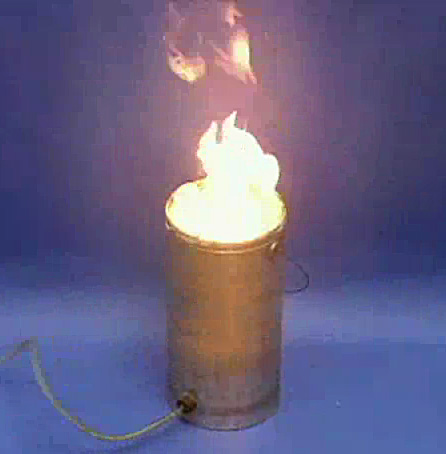This photograph from the “dust explosion” media piece is part of Chemistry Comes Alive! The demonstration illustrates the principle behind a grain elevator explosion.
By Terry Devitt, University of Wisconsin. If you’re a fan of the chemistry that makes things explode, glow, sputter, spin and change color, the Journal of Chemical Education has a Web site that will thrill your inner chemist. Produced at the University of Wisconsin-Madison, the Web site Chemistry Comes Alive! features hundreds of videos of ice bombs, dust explosions, beating hearts made of mercury and the bizarre behavior of ferro fluids, all aimed at demonstrating concepts in chemistry.
What’s more, the site now has the distinction of receiving the 2006 Pirelli Internetional Award for chemistry, a prestigious Web award that comes with a cash prize of 15,000 euro. The award was presented earlier this month in the Temple of Hadrian in Rome.
<br><br>
The site, according to Jon Holmes, editor of the Journal of Chemical Education Software, is geared for the general public and intended to share the awe-inspiring phenomena and beauty of chemistry. “We want to communicate to the public that science and chemistry, specifically, is exciting, thought-provoking and beautiful.”
<br><br>
Holmes explained that one of the motivations for the site was to inspire young people with the beauty and excitement of chemistry just as an earlier generation of chemists was inspired by chemistry sets.
<br><br>
The Chemistry Comes Alive! site is produced and maintained in the UW-Madison chemistry department by Holmes, chemistry professor John Moore and videographer Jerry Jacobsen. The site is a publication of the Journal of Chemical Education, which is owned and operated by the Division of Chemical Education of the American Chemical Society. The Chemistry Comes Alive! collection is currently being cataloged by the ChemEd DL, the NSDL Chemistry Pathway,
and will be available as part of their collections.
Established in 1996, the Pirelli Internetional Award is intended to foster the diffusion of scientific culture worldwide. Its chemistry selection committee includes one Nobel Laureate in chemistry.



I just can’t resist.
Can I add something about Nobel prizes in chemistry?
The Nobel Prize in Chemistry (Swedish: Nobelpriset i kemi) is awarded once a year by the Royal Swedish Academy of Sciences. It is one of the five Nobel Prizes established by the will of Alfred Nobel in 1895, awarded for outstanding contributions in physics, chemistry, literature, peace, and physiology or medicine since 1901. This award is administered by the Nobel Foundation and widely regarded as the most prestigious award that a scientist in the various fields of chemistry can receive. The first Nobel Prize in Chemistry was awarded in 1901 to Jacobus Henricus van ‘t Hoff, of the Netherlands, “for his discovery of the laws of chemical dynamics and osmotic pressure in solutions.” The award is presented in Stockholm at an annual ceremony on December 10, the anniversary of Nobel’s death. In 2007 the Nobel Prize in Chemistry was awarded to Gerhard Ertl (of Germany) “for his studies of chemical processes on solid surfaces”; he was awarded the prize amount of 10,000,000 SEK (slightly more than €1 million, or US$1.4 million).
i did my experiment on how a skittles color will disolve in warm or cold water fatser and the results ended up giving me warm water try it out your self maybe you’ll get the same results.